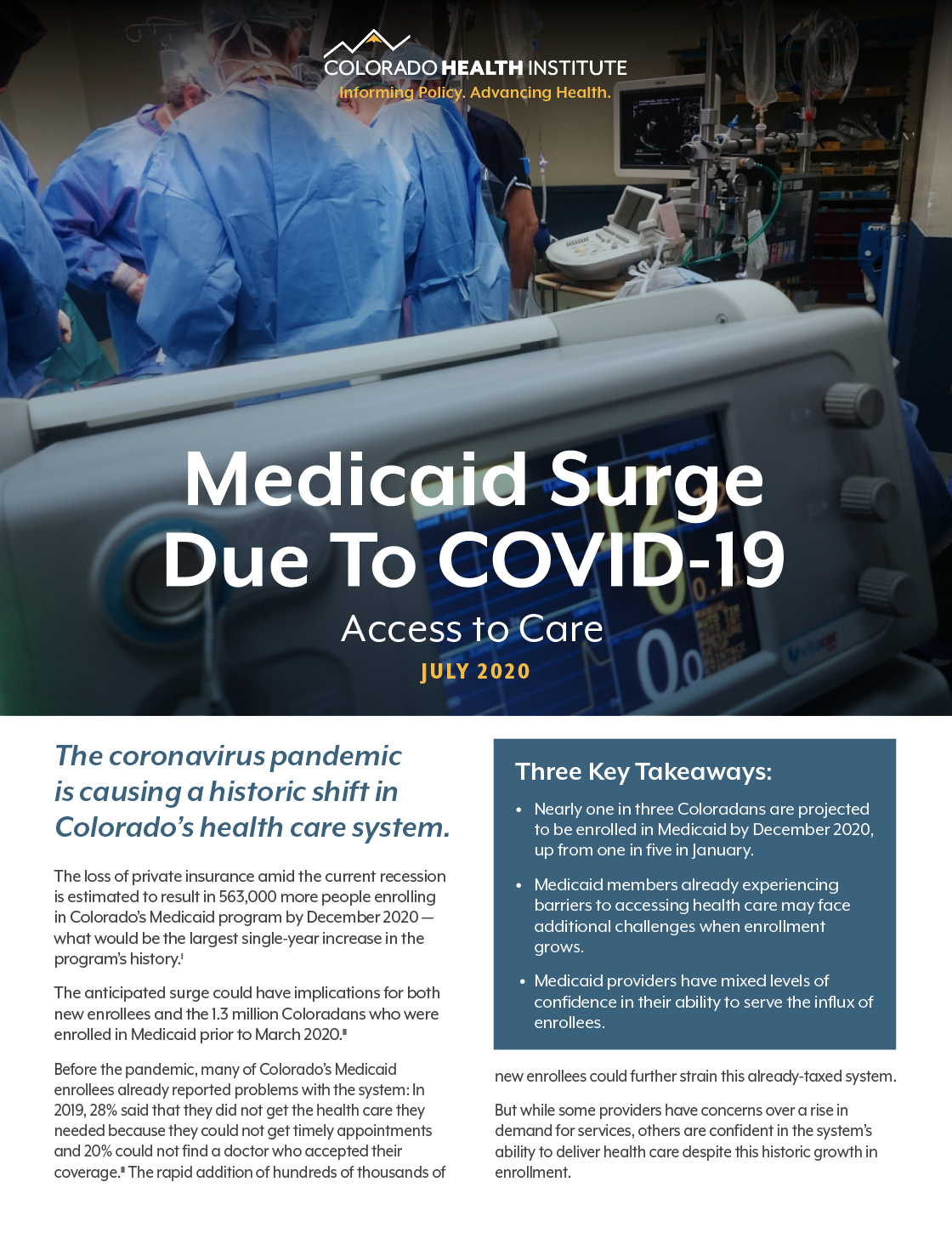
Medicaid Surge: Access to Care
The loss of private insurance amid the current recession is estimated to result in 563,000 more people enrolling in Colorado’s Medicaid program by December 2020 — what would be the largest single-year increase in the program’s history.
The anticipated surge could have implications for both new enrollees and the 1.3 million Coloradans who were enrolled in Medicaid prior to March 2020.
Before the pandemic, many of Colorado’s Medicaid enrollees already reported problems with the system: In 2019, 28% said that they did not get the health care they needed because they could not get timely appointments and 20% could not find a doctor who accepted their coverage. The rapid addition of hundreds of thousands of new enrollees could further strain this already-taxed system.
But while some providers have concerns over a rise in demand for services, others are confident in the system’s ability to deliver health care despite this historic growth in enrollment.
Key Takeaways
Nearly one in three Coloradans are projected to be enrolled in Medicaid by December 2020, up from one in five in January.
Medicaid members already experiencing barriers to accessing health care may face additional challenges when enrollment grows.
Medicaid providers have mixed levels of confidence in their ability to serve the influx of enrollees.
A Growing Medicaid Population’s Impact on Access to Care
If projections are correct, 2020 would see the largest increase in Medicaid enrollees in Colorado history. An estimated 31% of Colorado’s population will rely on Medicaid for health insurance by December 2020, up from 22% in January 2020. While the program grew by 289,000 in the first year and a half when eligibility was expanded in 2014 under the Affordable Care Act, the projected 2020 surge would be nearly twice as large—and providers have much less time to prepare.
Prior to COVID-19, Medicaid enrollees were already reporting problems accessing health care. As more patients join the Medicaid system, it could exacerbate these barriers.
More enrollees means more patients seeking care from the limited number of providers who accept Medicaid. In 2019, one in five Medicaid enrollees (20%) reported not receiving care due to their insurance, compared with 9% of people with non-Medicaid insurance. Providers say delayed payments and below-average reimbursement rates compared to Medicare and commercial insurance are deterrents to serving the Medicaid population.
The influx might also make appointments harder to schedule. In 2019, one in four Medicaid members (28%) said they could not get a doctor’s appointment when needed, compared to 21% of people with some other form of insurance.
The coronavirus pandemic also introduced a new barrier to care — forgoing needed care due to concerns over safety. A survey from the Kaiser Family Foundation found that 48% of Americans delayed or skipped care during the pandemic, prompted by concerns about safety and public health orders that suspended elective procedures. As regulations and restrictions surrounding the pandemic begin to ease, providers around the state will also have to address this backlog of deferred care.
Yet there may be some patterns that could suggest a less intense demand. When eligibility for Medicaid was expanded in 2014, most new enrollees were previously uninsured. In 2020, most new members are likely to be people who recently had private coverage, either through their job or the individual market. Many of these 563,000 new enrollees will have likely had health care in the recent past and may be less likely to have undetected or chronic conditions than those who have been uninsured and less likely to access care.
Providers anticipate that this new Medicaid population may have different needs from those enrolled prior to March 2020. New enrollees may be unemployed from high-paying jobs or might not frequently utilize the health care system due to their age or absence of chronic illnesses. Households that have had employer-based or private insurance in the years before the pandemic may have less pent-up demand for medical care.
Those who were enrolled prior to the pandemic, on the other hand, are more likely to face greater barriers to care due to social factors associated with lower incomes or have worse health due to chronic conditions related to age or injury. For example, a family of four that is eligible to enroll in Medicaid has an annual income of $36,156 or less. Families with lower incomes are less likely to have jobs with paid time off or sick leave, resulting in limited flexibility in scheduling doctors’ appointments.
Preparing for the Surge: A Mixture of Confidence and Concern
To understand how providers are preparing for these changes, CHI interviewed an internal medicine resident in Denver and leaders from three of Colorado’s seven Regional Accountable Entities (RAEs): Rocky Mountain Health Plans (RAE region 1) which covers the Western Slope and the Colorado Community Health Alliance (RAE regions 6 and 7), which cover counties along the western and southern Front Range. RAEs coordinate physical and behavioral health care in their regions. All interviewees reported feeling confident about their ability to provide quality care to these new members.
Interviewees at Colorado Community Health Alliance (CCHA), for one, said their system is ready because they anticipated higher Medicaid enrollment numbers in recent years than they actually served, and already have networks well equipped to absorb more members in 2020.
Providers may also be feeling equipped to handle the surge because it is likely temporary. While the exact number of enrollees who will shift — or churn — off of Medicaid and onto another type of coverage in the new year is unknown, many are expected to do so in January 2021, after the end of federal rules that prohibit disenrollment due to changes in employment or income during the coronravirus crisis.
Additionally, enrollment numbers may not be as high as anticipated. The number of people who enrolled in Medicaid was lower than expected in April and May of 2020. However, there are still five months left in the year.
But while many providers are confident in their current network infrastructure, they are still keeping a close eye on two concerns.

Concern #1: Mitigate an Influx of Backlogged Services
Regulations halted non-urgent care and services during the early weeks of the pandemic.
The fear of contracting COVID-19 in medical settings may result in Medicaid members playing catch-up on needed preventive care or treatments later on in the year if the pandemic subsides. According to a national survey by the Primary Care Collaborative in May 2020, more than 70% of clinicians are worried about an increase in patient volume after the initial pandemic wave.
Representatives from Colorado’s health care system echoed that concern: A director at Rocky Mountain Health Plans (RMHP), which runs the RAE on the Western Slope, is confident the system has the infrastructure to care for new enrollees but is concerned about the backlog of needed care for many Medicaid members who have chronic health conditions. For example, members who regularly receive medical care for their diabetes or hypertension may have missed routine check-ups, which could exacerbate their condition later on.
Skipping or forgoing care altogether can be dangerous. Medical providers note that people with chronic conditions may have further complications from putting off or forgoing needed care.
What Is Being Done
RAE leaders told CHI they are increasing care coordination and telehealth to better assist Medicaid members and avoid a backlog of needed care.
Bolstering care coordination teams to assist members with navigating their Medicaid network. Care coordination teams are an important component of a Medicaid network as they provide needed guidance on available services and the nuances of the Medicaid system. This can help members maintain good health between visits. These teams include staff such as registered nurses, social workers, community resource specialists, and behavioral health coordinators. They work with members and their families to provide connections to medical and non-medical services in their network, assist with enrollment to providers, or explain the nuances of the Medicaid system. They have seen an uptick in calls from members and are growing their expertise on questions related to health care and social issues such as housing or transportation.
Use of telehealth to serve more members without compromising their safety. The use of telehealth services may help mitigate a backlog of services as it allows patients to communicate with providers and attend check-ups without leaving their homes. The availability of telehealth services may reduce the number of people accessing in-person care while still allowing for routine check-ups to continue.
The use of telehealth services has increased since the coronavirus pandemic reduced in-person medical appointments. The Centers for Medicare and Medicaid Services (CMS) is allowing for temporary reimbursements for providers to deliver care to members who are unable to seek medical services to due to sickness or concerns over COVID-19.
Yet clinicians note that some patients will need assistance with using these new platforms, while others will need technology that can support telehealth services. Low-income or rural Coloradans, many of whom rely on Medicaid services, are more likely to have limited access to broadband or telehealth technologies.
Providers in some RAE regions have begun using practice transformation coaches, who assist physicians with providing quality care, to help set up telehealth platforms.
CCHA has been using its Member Advisory Committees, which are comprised of Medicaid members in their network, to gather feedback from members and caregivers about their experiences with telehealth services. From these meetings, providers learned that a majority of telehealth users have a positive interaction with the service because it allows them to access care remotely. However, lack of access to broadband is still prevalent in some communities and needs to be addressed before telemedicine is adopted as a permanent alternative source of care.

Concern #2: Workforce shortages may be heightened in some areas
As Medicaid enrollment continues to climb, some medical and administrative staff are concerned about keeping up with demand.
One internal medicine resident in Denver shared concerns about hospitals’ ability to care for additional patients. The number of available beds and capacity of the nursing staff play an important role in how many patients can be cared for. When nursing capacity is stretched thin, the quality of care can drop.
The same medical provider said that hospitals experience challenges when trying to discharge patients. Making space for incoming patients requires a quick turnover, but it is hard to find openings at long-term care facilities or clinics to accept discharged patients during a pandemic.
Staff at RMHP noted another type of staffing challenge: furloughs and layoffs. Hospitals and clinics in some rural areas saw below-average patient volumes during the pandemic. With less revenue from emergency department visits and routine check-ups, many health care providers were forced to reduce their staffing numbers. (CHI’s recent report Medicaid Surge Due To COVID-19: Financial Impacts for Hospitals delves into the financial challenges many hospitals are facing.)
The influx of Medicaid enrollees will increase demands on administrative staff to oversee, navigate, and enroll new members. Staff at RMHP said that one of the most important steps in the coming months will be making sure people are getting enrolled.
Capacity concerns are not keeping all providers awake at night. Staff from CCHA reported they have not experienced massive layoffs or furloughs. They credit the accelerated release of incentive funds to help primary care practices offset reduction in revenue related to COVID-19. The incentive funds were provided to eligible providers and were a combination of key performance indicator incentives and performance pool dollars. These payments allowed clinics to stay afloat when they were on the cusp of closing due to low patient volume.
What Is Being Done
Colorado Department of Health Care Policy and Financing’s (HCPF’s) Revised Attribution Plan: To accommodate the influx of enrollees, HCPF revised how members will be attributed or “assigned” to primary care providers. According to its “Accountable Care Collaborative Member Attribution — Response to COVID-19” plan, the department is temporarily changing its methodology from attribution based on geographic location to attribution based on a provider’s capacity to accept new patients or expertise in caring for large numbers of members
Evaluating Provider Capacity: Some RAEs are using annual provider network adequacy reviews to determine individual provider capacity. These reviews have been a successful tool for CCHA to evaluate its providers’ capacity and what areas may need additional support during the enrollment surge. Their internal analysis found that primary care providers in their regions have the capacity to absorb the projected influx of enrollees.
Increasing Recruitment of Medicaid Providers: HCPF is using social media to actively recruit providers to join the Medicaid network. The department is reducing application barriers, such as fees and fingerprinting, to streamline the enrollment process and help increase the number of Medicaid providers statewide.
Modifying Provider Qualifications: Statewide, Colorado has temporarily modified provider qualifications, allowing certain licensed professionals, such as certified nursing aides and occupational therapists, to be cross-trained and assigned new responsibilities.
Conclusion
Colorado’s Medicaid system is moving into uncharted waters. A historic increase in Medicaid enrollment is likely to challenge Colorado’s Medicaid network as medical and administrative staff strive to meet the demand for services in the coming months.
Some medical and administrative providers feel confident the system’s infrastructure will be able to support the influx, while others are unsure if their staffing levels are sufficient to serve thousands more people.
There are unknowns about how the new enrollees will interact with the Medicaid system, but providers share some concerns over Medicaid enrollees with chronic conditions having skipped or foregone care during the pandemic and how an influx in members might limit or impede access to needed services.
Looking ahead, providers can continue to support their administrative staff and care coordination teams as they steadily enroll as many as 560,000 people and help them navigate the system. Coordination between HCPF and RAE region leaders will be imperative as the number of enrollees steadily increases throughout the year. They will need to continually evaluate the system’s capacity and solicit feedback from primary care providers and members to understand how these changing dynamics may affect the health of people enrolled in Colorado’s Medicaid program.
The state also has a role in helping increase and maintain coverage in Colorado. The state has passed emergency waivers and executive orders to do the following:
• Allow the state to waive prior authorization – the requirement that doctors get permission before prescribing a medication or performing a procedure – in some cases.
• Let nursing facilities admit new residents before performing some screenings about the level of care a person needs. Normally, those screenings are required before a person can move in.
• Give people who apply for Medicaid coverage more time to request a hearing if they’re denied.
• Make it easier for out-of-state providers to get paid for care provided to Colorado Medicaid members. For example, a person who was visiting family in another state might have gotten stuck because of lockdowns and need to receive care there.
• Continue to pay long-term care facilities like nursing homes even if they must evacuate residents to an unlicensed facility. Normally, providers can only use buildings certified as meeting a wide variety of safety rules.
• Suspend the requirement that Medicaid members prove their incomes have not risen above the eligibility threshold.
• Allow early refills for most medications and dispense more in each filling.
• Expand telemedicine coverage, increase payments for some virtual services and reduce patients’ out-of-pocket costs.
• Allow more home-based services for people with disabilities to be provided virtually and allow services to move forward before certain assessments by a doctor are complete.
• Let some family caregivers be paid for services to their relative who qualifies for professional care under Medicaid.
• Increase payments to some health care providers.





